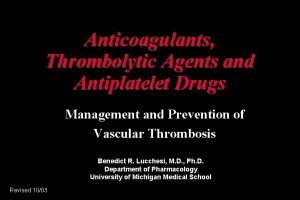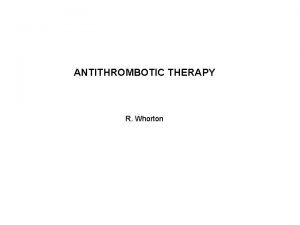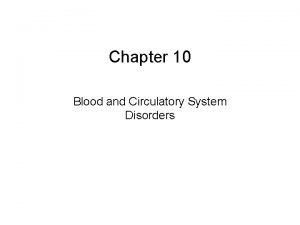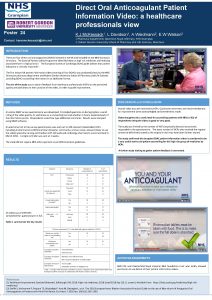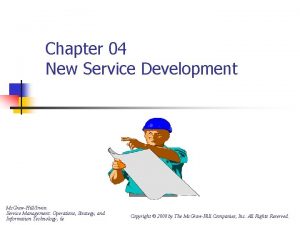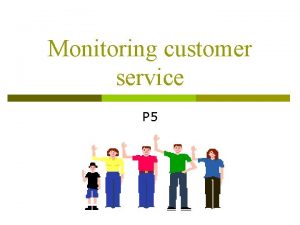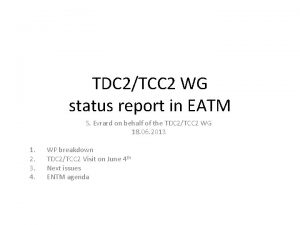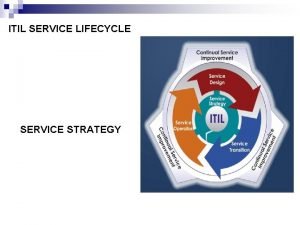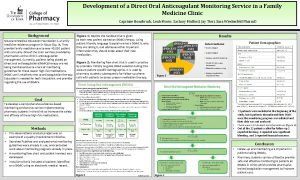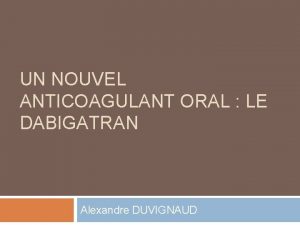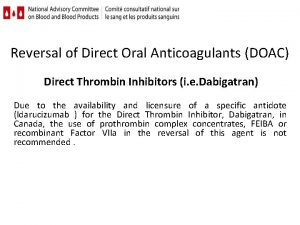Development of a Direct Oral Anticoagulant Monitoring Service
























- Slides: 24

Development of a Direct Oral Anticoagulant Monitoring Service in a Family Medicine Clinic Caprisse Honsbruch, Leah Mouw, Zachary Mulford, Jay Tieri, Sara Wiedenfeld Pharm. D

Introduction

Practice Site Siouxland Medical Education Foundation • 18 family medicine residents • 8 faculty physicians • 2 physician assistants • 2 clinical pharmacists • ~14 Iowa pharmacy students per year Care for over 40, 000 patient visits annually Pharmacist’s are responsible for 100% of anticoagulated ambulatory and nursing home patients • Warfarin • Direct Oral Anticoagulants

What’s the Problem? Direct Oral Anticoagulant (DOAC) therapy is relatively new to anticoagulation therapy Patients started on DOAC therapy are not being monitored at all • No lab monitoring • Bleeding risk Education is needed for both the patient and provider regarding the use of DOACs Dabigatran Oct 2010 Rivaroxaban 2011 Jan 2015 Dec 2012 July 2011 2010 Edoxaban Apixaban 2012 2013 2014 2015

Goal: Develop a comprehensive evidencebased monitoring service that can be implemented in the clinic to increase the safety and efficacy of these high risk medications.

Methods Develop a patient education handout • Important information about each medication • Adverse effects • Where to find more information Develop a flow chart for providers to monitor DOAC use • Important labs • Appropriate follow-up and questions Collect Data • Follow-up phone calls • Patient education provided • Remarkable Findings

Patient Handout


Direct Oral Anticoagulants (DOAC)

Your DOAC

Patient Friendly Language

Provider Flow Chart

Start of Therapy • Collect patient past medical history • Collect Labs: BMP and calculate Cr. Cl, CBC • Provide patient with patient education handout • Educate about signs and symptoms of DVT and stroke • a. Determine indication for usage (DVT, PE, stroke, Afib), and duration of therapy a. b. c. d. Switching from warfarin? (See Figure 1) First provoked clot 3 -6 months Unprovoked clot 3 months-to extended 2 nd clot or A Fib extended therapy b. • DVT/PE: unilateral pain, numbness, shortness of breath, chest pain Stroke: Facial droop, Arm weakness, Slurred speech, Time to call 911 Financial Analysis a. b. Is the medication covered by patient’s insurance? Is there a manufacturer’s coupon available?

2 Week Follow-Up • Ask patient if they have any questions or concerns • Assess adherence have they missed any doses in the last week • Are there any bleeding concerns? Ex: excessive bruising, bloody nose, black tarry stools • Any signs or symptoms of stroke, or DVT/PE? • Have they started any new medications? If yes, see Figure 2 for possible interactions

4 -6 Week Follow-Up • Repeat same questions as in week 2 • Ask about refills. Have they refilled their medication? Do they need refills on their medication?

3 Month Follow-Up • Repeat same questions from weeks 4 -6 Follow-up 6 months (High Risk) • Appointment in person every 6 months if: a. Cr. Cl <60 ml/min b. Age ≥ 75 y/o c. Same questions, and repeat labs Follow-up 1 year (low risk) • Appointment in person annually for all others: a. Same questions b. Repeat labs

Results

Patient Demographics • • Average age: 68. 5 years Race: 79% Caucasian Type of DOAC • DOAC Prescribed Sex: 61% male Rivaroxaban Apixaban Dabigatran 0 5 10 15 20 25 Nubmer of patients Indications for use of DOACs 6; 9% 2; 3% A fib/ A flutter DVT/ PE 13; 19% 46; 69% VTE and A fib Other 30 35

Interventions made from monitoring program 6; 5% 7; 6% 29; 26% DOAC stopped Aspirin stopped 22; 20% 1; 1% Patients called for follow up CHADS 2 VASc scores documented Financial assistence set up 47; 42% Patients scheduled for overdue lab work

Monitoring 22 patients were called: • 2 reported bruising • 1 reported bleeding (non-significant) • 1 reported financial concerns

Conclusion

Moving Forward • Follow-up and monitoring are important in patients taking DOACs • Pharmacy students can be utilized to provide safe and effective monitoring to patients on DOACs • Continue to implement monitoring into the workflow • Continue to collect data • Assess adherence • Report remarkable outcomes

References • • Bartoli-Abdou JK, Patel JP, Crawshaw J, et al. Exploration of adherence and patient experiences with DOACs one year after switc hing from vitamin-K antagonists- insights from the switching study. Thromb Res. 2018; 162: 62 -68. Conway SE, Hwang AY, Ponte CD, Gums JG. Laboratory and Clinical Monitoring of Direct Acting Oral Anticoagulants: What Clinicians Need to Know. Pharmacotherapy 2017; 37: 236 -48. Douxfils J, Ageno W, Samama CM, Lessire S, et all. Laboratory testing in patients treated with direct oral anticoagulants: a practical guide for clinicians. J Thromb Haemost. 2018; 16(2): 209 -219. Kim JJ, Hill HL, Groce JB, Granfortuna JM, Makhlouf TK. Pharmacy Student Monitoring of Direct Oral Anticoagulants. J Pharm Pract 2018. Savaysa (R) [package insert]. Tokyo, Japan: Daiichi Sankyo Inc; 2015. Pradaxa (R) [package insert]. Ingelheim am Rhein, Germany: Boehringer Ingelheim; 2010. Xarelto( R) [package insert]. Beerse, Belgium: Janssen Pharmaceuticals Inc; 2011. Eliquis (R) [package insert] New York, NY: Pfizer Inc; 2016

 Jean connors md
Jean connors md Thrombolytic vs anticoagulant
Thrombolytic vs anticoagulant Anticoagulant examples
Anticoagulant examples Heparin anticoagulant
Heparin anticoagulant An anticoagulant is a substance that prevents
An anticoagulant is a substance that prevents Anticoagulant drugs
Anticoagulant drugs Warfarin strengths and colors
Warfarin strengths and colors Anticoagulant
Anticoagulant Anticoagulant
Anticoagulant Prepare a service blueprint for 100 yen sushi
Prepare a service blueprint for 100 yen sushi ___________ helps in managing lifecycles on cluster node.
___________ helps in managing lifecycles on cluster node. Service availability monitoring
Service availability monitoring Monitoring customer service
Monitoring customer service Wg status monitoring service
Wg status monitoring service Wg status monitoring service
Wg status monitoring service Copernicus
Copernicus Psycho-sexual theory
Psycho-sexual theory Phallic stage
Phallic stage Oral stage of development examples
Oral stage of development examples Freud’s psychoanalytic theory of personality
Freud’s psychoanalytic theory of personality Direct material + direct labour
Direct material + direct labour Umass hr direct login
Umass hr direct login Itil service lifecycle service transition
Itil service lifecycle service transition Itil five stages
Itil five stages Continual service improvement 7 steps
Continual service improvement 7 steps

